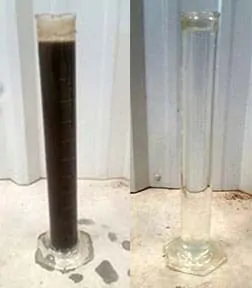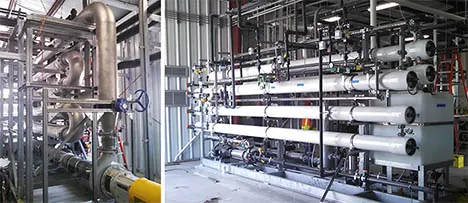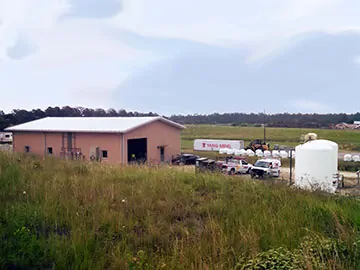

See SCS Engineers Landfill Leachate Services
High-density polyethylene pipes have been used for landfill leachate collection and conveyance lines for several decades because of the chemical compatibility of HDPE material with many different types of liquids and chemicals. Designing a leachate collection system for a landfill disposal cell involves numerous engineering analyses of different components involved in collecting and conveying leachate. One of the important engineering evaluations is a determination of structural stability of HDPE leachate collection pipes at the bottom of the landfill.
Structural Stability of HDPE Pipe
Modern landfills are gradually becoming larger and deeper; deeper landfills will naturally impose a higher surcharge loading on the HDPE leachate collection pipes below the waste column. Engineering methodologies for the structural stability evaluation of HDPE pipes with significant surcharge loading have been around as long as HDPE pipes have been in production.
There are three criteria used when evaluating the structural stability of HDPE pipes; wall crushing, wall buckling, and ring deflection. Wall crushing can occur when the stress in the pipe wall, due to external vertical pressure, exceeds the compressive strength of the pipe material. Wall buckling, a longitudinal wrinkling in the pipe wall, can occur when the external vertical pressure exceeds the critical buckling pressure of the pipe. Ring deflection is the change in vertical diameter of the pipe as the pipe deforms under the external pressure. Empirical formulas by HDPE pipe manufacturers or researchers are available to check each criterion.
SDR 11 vs. SDR 17 HDPE Pipe
When a structural stability evaluation involves high surcharge loading on the pipe, an engineer may automatically select SDR 11 HDPE pipe without going through an evaluation process. The engineer’s reasoning is that the higher wall thickness of SDR 11 pipe, as compared to SDR 17 pipe, is the logical choice because it provides a higher level of structural stability to the pipe. In the case of wall bucking and wall crushing, where the pipe strength in these two criteria is inversely proportional to the SDR value, the engineer is making the right choice. The strength is greater for the lower SDR value that represents thicker pipe wall thickness; making SDR 11 stronger than SDR 17.
However, in the case of ring deflection, the pipe strength is not a function of SDR, but a function of another parameter called allowable ring deflection. The allowable ring deflection value varies from one SDR to another and is generally reported by pipe manufacturers. The allowable ring deflection for SDR 17 pipe is greater than all other SDR pipes, which makes SDR 17 pipe stronger when considering ring deflection. SDR 17 pipe is also the most commonly used HDPE pipe in the landfill industry, being lighter in weight per unit length of the pipe than SDR 11, thus making it less expensive than SDR 11 pipe.
Which Is Best For My Landfill?
SCS Engineers recommends that landfill engineers consider SDR 17 pipe as the first choice for use as a leachate collection pipe below the waste column, and then other SDRs if SDR 17 does not pass the three structural stability criteria mentioned above.
Read more blogs by Ali Khatami, click here and type “Advice from the Field” in the search box.
Landfill operators are seeking new means to dispose of leachate generated at their facilities more economically. Rising costs of leachate treatment at publicly owned treatment works (POTWs) obliges landfill operators to look for alternative disposal means at a lower price. These situations encourage landfill operators and consultants to do more with less when designing preventative solutions to reduce leachate generation in the first place.
Upstream measures to reduce leachate generation range from standard operating procedures to innovative ideas with significantly high benefit to cost ratios. SCS compiled a list of our Top 10 measures to consider, including:
1. Grading – Creating landfill plateaus to maximize rainwater runoff toward perimeter storm water ditches, using low permeable soil to seal landfill slopes that will not receive waste for an extended time.
2. Caps & Covers – Using temporary geomembrane caps over areas that will not receive waste for a long time. Constructing final cover over landfill final slopes to eliminate rainwater percolation into landfill.
3. Swales – Constructing temporary and strategic swales on landfill outside slopes to capture rainwater runoff before causing soil erosion on the slope and to convey runoff water to perimeter ditches.
4. Berms & Downchutes – Constructing temporary berms and swales on landfill slopes that drain toward new disposal cells to capture water before reaching waste in the new cell and directing water to perimeter ditches. Also, constructing a berm at the crest of slopes to minimize the flow of rainwater runoff over slopes that are causing soil erosion. Constructing engineered temporary and sturdy downchutes for rainwater runoff from top areas of the landfill to the perimeter ditches.
5. Tarps – Installing rain tarp over a portion of a new cell that will not be in service for some time.
6. Exposure – Minimizing exposure of the active face while the remaining areas are properly graded to shed rainwater runoff to perimeter ditches.
7. Shedding – Grading the top area of each lift to shed rainwater runoff to outside slopes and the perimeter ditches.
8. Plantings – Installing sod or seeding on exterior slopes and those interior slopes that will not receive waste for an extended time to reduce soil erosion.
9. Roads – Constructing ditches adjacent to access roads to safely convey runoff water to the bottom of the slope – pitching access roads toward the ditch adjacent to the road, and building a proper road surface to minimize erosion during severe storms while lasting long under traffic loading.
10. Maintenance – Establishing routine maintenance protocol for the aforementioned measures because regular maintenance sustains long life and performance.
For facilities outside the landfill area, special measures, such as using floating covers on leachate ponds or canopies over operations that could potentially generate leachate without the canopy, also help reduce leachate generation.
Upstream measures are not necessarily limited to our Top 10 list but depend on the type and extent of operations at a facility. The will of the landfill operator and the expertise of the solid waste engineer can go a long way to reducing leachate generation at landfill facilities, and we all strive for that.
More about Liquids Management including case studies.
Many landfill operators and owners are now spending more than 10 or 20 cents per gallon for leachate management, which can become quite costly. One of the primary reasons that leachate management has become an expensive challenge in the United States is more stringent regulatory policies regarding the discharge of liquids into public waters. The regulations affect publicly owned treatment works (POTW), which has led some POTWs to require that leachate entering their plants have adequate pre-treatment to remove contaminants. Under these circumstances, some landfills are forced to collect and haul their leachate to a different POTW or to consider installation of pre-treatment equipment themselves.
Each landfill needs a solution to its leachate management issues that depends on applicable regulatory restrictions, the capability of the local POTW, and the leachate composition. Due to chemical reactions and biological activity inside the landfill, the leachate’s temperature is frequently warmer than area groundwater. Also, leachate is odorous, and generally brown in color, with colloidal suspended solids. The composition of leachates depends on the composition of a landfill’s waste, the landfill’s decomposition stage, and weather conditions. Many factors are evaluated to arrive at an efficient and economical treatment method for disposal of landfill leachate.
There are some treatment alternatives available to reduce the high organic and nitrogen loads in leachate. For some leachate applications, the treatment methods are sufficient to allow the POTW to process the leachate safely. If treatment is not possible, or cost prohibitive another alternative is to pre-treat the leachate, lowering the contaminant load to prevent subsurface precipitation, and then dispose of it using deep well injection. Some states require little or no pre-treatment before discharging leachate to deep injection wells.
The following technologies are available for the pre-treatment of landfill leachate: biological processes for wastewater treatment such as membrane bioreactors, sequencing batch reactors, activated sludge processes plus reverse osmosis. Wet oxidation processes, activated carbon adsorption, as well as precipitation, coagulation, and flocculation techniques are also used, depending on the contaminants and their concentrations. These two counties are using a combination of treatment technologies for their leachate management strategies.
Hillsborough County’s 60,000 Gallon Per Day Leachate Treatment Facility at Southeast County Landfill
New Hanover County’s Landfill Leachate Treatment Plant Using Reverse Osmosis
Effective leachate management applies unique combinations of technologies which most adequately address the previously mentioned factors. To provide a truly sustainable solution to leachate management, SCS suggests another approach, which is to consider the landfill design and operations as part of the solution. By using the existing landfill design and operations, SCS develops an integrated approach to leachate management that is preventative. The benefits of using an integrated approach are that they are often a more cost-effective solution in the long-term, sustainable, working with the existing landfill’s infrastructure.
Waste Management is using an integrated approach at Monarch Hill Landfill in Pompano Beach, Florida. Monarch Hill Landfill is a 385-acre landfill with a waste flow of 5,000 tons per day. SCS helped decrease leachate formation as part of overall landfill design and operation. Waste Management reduced leachate formation using the following methods:
Temporary caps – SCS designed and provided monitoring services during installation of a 10-acre temporary geomembrane cap over a portion of the top intermediate plateau of the landfill. It reduced leachate generation, decreased odors, increased gas collection efficiencies, and addressed leachate seeps on the slope, as well as making surface water runoff over the top of the landfill easier and more efficient.
Final covers – SCS designed, permitted, and provided monitoring services during construction of six partial closure projects. The final covers were equipped with leachate toe drain systems below the final cover geomembrane, enabling leachate seeps to be collected and disposed of efficiently. The design also allowed collection of gas from the lower portion of the slope after completion.
Rainwater Toe Drain Systems – SCS designed a toe drain system above the final cover geomembrane that enabled water to be collected and diverted to the landfill perimeter ditches, preventing pore pressure build up and keeping the system stable.
Tack-on Swales – SCS designed tack-on swales that were implemented to catch runoff and convey water to downchute pipes. The swales could be easily adjusted based on the size of each partial closure and the overall management of stormwater.
Our approach is to develop a robust, tailored liquids management program comprised of the most appropriate technologies and engineering design to tackle the unique set of challenges facing each landfill client. In an era of doing more with less, clients find our programs are more cost-effective because they are more efficient and well designed.
Learn more at SCS Liquids Management
Contact one of our National Experts or :
Darrin Dillah: Landfill Leachate – Upstream
Ron Wilks: Landfill Leachate – Downstream and Evaporators
Monte Markley: Deep Well Injection
Bob Speed: Dewatering
Ali Khatami: Landfill Engineering and Construction Impacts on Liquids Managment
Sam Cooke: Industrial Wastewater Treatment
SCS Engineers met a tight, non-negotiable regulatory deadline to get the new plant on-line while meeting non-toxic effluent standards.

Everyone enjoys before and after pictures; just look at the results New Hanover County’s program is producing. This and other County programs are helping this North Carolina county reduce reliance on landfill disposal while creating a comprehensive and sustainable solid waste management system that is protective of the environment.
In 2016 a new wastewater treatment plant was commissioned at the New Hanover County Landfill. The new facility processes approximately 65,000 gallons per day (GPD) of leachate using state-of-the-art ultrafiltration (UF) and reverse osmosis (RO) technologies to meet or exceed federal and state treatment standards.
The raw leachate is pre-treated in an existing aerobic lagoon followed by a sequencing batch reactor (SBR) to reduce organic constituents. The pretreated effluent then flows into the membrane system. Using state-of-the-art membrane filtration technology, including ultrafiltration (UF) pictured at lower left, and a reverse osmosis (RO) system, pictured lower right, to produce crystal clear, effluent discharged to an upper tributary of the Cape Fear River.

The new facility can process 75,000 GPD and the Wastewater treated through the new system meets state Drinking Water standards for quality.
Tough surface water discharge standards and predictable performance in cold weather drove the design to use UF/RO systems. The results are impressive; metals including arsenic are BDL, ammonia <0.2 ppm, and TSS < 2 ppm. The system produces approximately 13,000 GPD of RO concentrate that is pumped to the working face and safely disposed of in the landfill. The County has certified operators that have played a big role in getting the plant shaken down and running smoothly.

“New Hanover County is an industry leader in adopting proven technologies to better manage solid waste, and protect the environment. This kind of planning and approach can benefit many other public works departments,” stated Bruce Clark, PE, BCES, LEED AP®, and SCS Engineers National Expert on Waste Conversion.
As Joe Suleyman, the County’s Environmental Management Director put it, “Let’s face it – people move to New Hanover County because they love to be in, on, or near the water. Our technical staff is composed of very talented folks who have environmental science and biology backgrounds. They believe in what they’re doing to help protect our delicate coastal environment, and this state-of-the-art system is a huge stride towards meeting our own expectations and those of the citizens we serve.”
See more case studies, services, and professionals on the SCS Engineers – Liquids Management Website